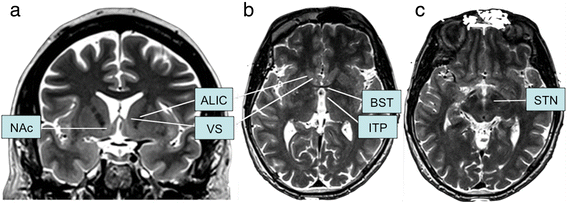Deep brain stimulation for treatment-refractory obsessive compulsive disorder: a systematic review
- PMID: 25085317
- PMCID: PMC4149272
- DOI: 10.1186/s12888-014-0214-y
Deep brain stimulation for treatment-refractory obsessive compulsive disorder: a systematic review
Abstract
Background: Obsessive-compulsive disorder is one of the most disabling of all psychiatric illnesses. Despite available pharmacological and psychotherapeutic treatments about 10% of patients remain severely affected and are considered treatment-refractory. For some of these patients deep brain stimulation offers an appropriate treatment method. The scope of this article is to review the published data and to compare different target structures and their effectiveness.
Methods: PubMed search, last update June 2013, was conducted using the terms "deep brain stimulation" and "obsessive compulsive disorder".
Results: In total 25 studies were found that reported five deep brain stimulation target structures to treat obsessive-compulsive disorder: the anterior limb of the internal capsule (five studies including 14 patients), nucleus accumbens (eight studies including 37 patients), ventral capsule/ventral striatum (four studies including 29 patients), subthalamic nucleus (five studies including 23 patients) and inferior thalamic peduncle (two studies including 6 patients). Despite the anatomical diversity, deep brain stimulation treatment results in similar response rates for the first four target structures. Inferior thalamic peduncle deep brain stimulation results in higher response rates but these results have to be interpreted with caution due to a very small number of cases. Procedure and device related adverse events are relatively low, as well as stimulation or therapy related side effects. Most stimulation related side effects are transient and decline after stimulation parameters have been changed.
Conclusion: Deep brain stimulation in treatment-refractory obsessive-compulsive disorder seems to be a relatively safe and promising treatment option. However, based on these studies no superior target structure could be identified. More research is needed to better understand mechanisms of action and response predictors that may help to develop a more personalized approach for these severely affected obsessive compulsive patients.
Figures


References
-
- Modell JG, Mountz JM, Curtis GC, Greden JF. Neurophysiologic dysfunction in basal ganglia/limbic striatal and thalamocortical circuits as a pathogenetic mechanism of obsessive-compulsive disorder. J Neuropsychiatry Clin Neurosci. 1989;1(1):27–36. - PubMed
Publication types
MeSH terms
LinkOut - more resources
Full Text Sources
Other Literature Sources
Medical

